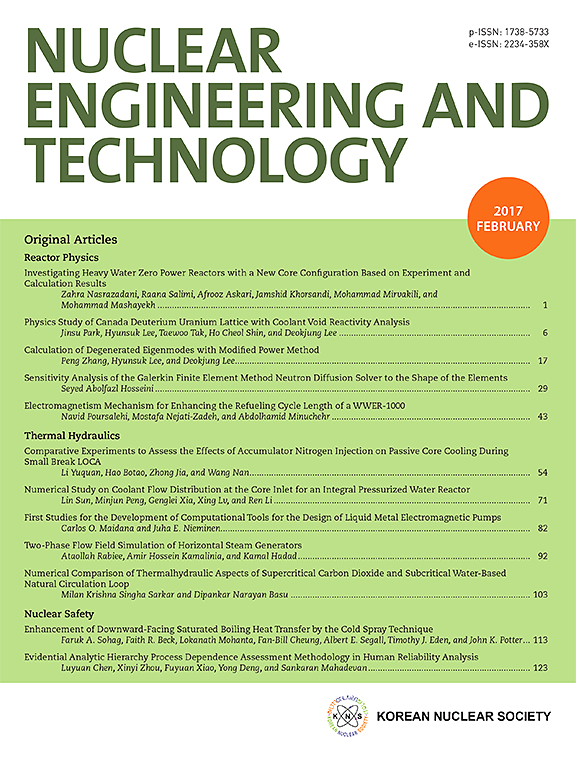Electric double layer and thermal radiation effects on micropolar blood particles conveying Cu-MoS2-CuO nanoparticles in squeezed arterial channel
IF 2.6
3区 工程技术
Q1 NUCLEAR SCIENCE & TECHNOLOGY
引用次数: 0
Abstract
The rotational motion of the blood particles in the squeezed arterial channel is important for advancing biomedical applications such as targeted drug delivery and diagnostic devices. In the present framework, we study the rotational motion of the blood particles and electric double layer (EDL) flow containing molybdenum disulfide copper oxide (CuO), copper (Cu) ternary nanofluid in an arterial squeezed channel. To enhance the model's novelty, the Poisson-Boltzmann equation is utilized with the Debye-Hückel approximation to estimate the electric potential accurately. Also, we explore the impact of thermal radiation mechanisms along with thermal slip and heat sources to better understand heat transfer phenomena. The arising differential system composed of momentum, and temperature equations is treated through a numerical approach called the finite element method. Results demonstrate that an increase in the Hartmann number leads to a reduction in velocity profiles by up to 30 %, while a higher zeta potential parameter enhances flow velocity by 15 %. Additionally, microrotation of blood particles increases by 20 % with elevated vortex viscosity. Thermal radiation significantly improves heat transfer rates, as evidenced by an 18 % rise in the Nusselt number under intensified thermal slip conditions. These findings present critical insights for optimizing biomedical flows and heat transfer mechanisms in engineering applications.
电双层和热辐射对挤压动脉通道中输送Cu-MoS2-CuO纳米颗粒的微极血颗粒的影响
血液颗粒在挤压动脉通道中的旋转运动对于推进生物医学应用(如靶向药物输送和诊断设备)非常重要。在此框架下,我们研究了含二硫化钼(MoS2)、氧化铜(CuO)、铜(Cu)三元纳米流体在动脉挤压通道中的血液粒子和双电层(EDL)流动的旋转运动。为了提高模型的新颖性,利用泊松-玻尔兹曼方程和德拜-赫 ckel近似来准确估计电势。此外,我们还探讨了热辐射机制以及热滑移和热源的影响,以更好地理解传热现象。由动量方程和温度方程组成的上升微分系统通过称为有限元法的数值方法进行处理。结果表明,哈特曼数的增加导致速度分布的降低高达30%,而更高的zeta势参数使流速提高15%。此外,随着旋涡粘度的升高,血液颗粒的微旋转增加了20%。热辐射显著提高了传热率,在热滑移加剧的条件下,努塞尔数上升了18%。这些发现为优化生物医学流动和工程应用中的传热机制提供了重要的见解。
本文章由计算机程序翻译,如有差异,请以英文原文为准。
求助全文
约1分钟内获得全文
求助全文
来源期刊

Nuclear Engineering and Technology
工程技术-核科学技术
CiteScore
4.80
自引率
7.40%
发文量
431
审稿时长
3.5 months
期刊介绍:
Nuclear Engineering and Technology (NET), an international journal of the Korean Nuclear Society (KNS), publishes peer-reviewed papers on original research, ideas and developments in all areas of the field of nuclear science and technology. NET bimonthly publishes original articles, reviews, and technical notes. The journal is listed in the Science Citation Index Expanded (SCIE) of Thomson Reuters.
NET covers all fields for peaceful utilization of nuclear energy and radiation as follows:
1) Reactor Physics
2) Thermal Hydraulics
3) Nuclear Safety
4) Nuclear I&C
5) Nuclear Physics, Fusion, and Laser Technology
6) Nuclear Fuel Cycle and Radioactive Waste Management
7) Nuclear Fuel and Reactor Materials
8) Radiation Application
9) Radiation Protection
10) Nuclear Structural Analysis and Plant Management & Maintenance
11) Nuclear Policy, Economics, and Human Resource Development
 求助内容:
求助内容: 应助结果提醒方式:
应助结果提醒方式:


